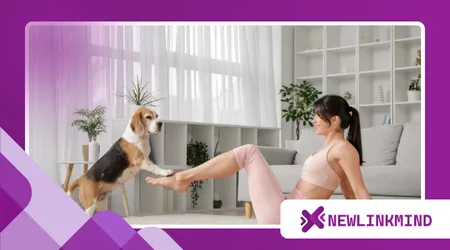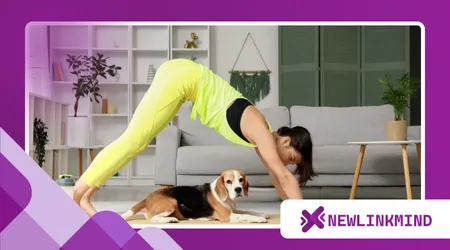Yoga with Pets: How to Include Your Dog or Cat in Practice

Anúncios
For the millions of us who practice yoga with pets at home, our furry companions are more than just roommates—they are integral to our lives.
The growing popularity of incorporating dogs and cats into a personal yoga practice is a testament to the powerful, stress-reducing bond we share.
This isn’t just a gimmick; it’s a genuine movement built on a foundation of emotional connection and mutual well-being.
But what exactly does practicing yoga with an animal look like, and how can you do it safely and effectively?
It’s about more than just striking a pose next to your pet; it’s about a shared moment of presence.
Anúncios
The Science Behind the Human-Animal Bond
The incredible bond between humans and animals is not merely anecdotal. It is rooted in profound physiological and psychological benefits.
When we interact with our pets, our bodies release oxytocin, the “love hormone,” while simultaneously reducing cortisol, the stress hormone.
A 2024 systematic review by researchers at the CABI Digital Library found a modest but significant link between pet ownership and reduced symptoms of depression.
Anúncios
This shows how your four-legged friend can be a powerful force for mental health. This is the same principle that makes your yoga practice so beneficial for relaxation.
Why not combine these two powerful forces? It’s like having a dedicated meditation partner who offers unconditional love.
Understanding the Approach: Doga and Coga
Practicing yoga with pets is not about forcing your animal into an uncomfortable pose. Instead, it’s about adapting your routine to include their natural movements and presence.
Think of it as a collaborative dance, not a rigid exercise class. For dogs, this is often called “Doga,” while for cats, it’s playfully known as “Coga.”
Read more: 10 Poses to End Your Day with Peace and Relaxation
The key is patience, respect, and a lighthearted attitude. Your pet’s participation will vary.
Some dogs may love lying beneath your Downward-Facing Dog, while cats might prefer to observe from a comfortable distance.
Poses for Your Dog-Friendly Yoga Session
When you practice with your dog, you can use poses that naturally invite them to participate.
The most obvious is Downward-Facing Dog (Adho Mukha Svanasana). As you settle into this pose, your dog may be curious and try to walk or lie down underneath you.
This creates a charming visual and a tender interaction. Another great pose is Extended Puppy Pose (Uttana Shishosana), which mirrors a dog’s natural stretch.
You can do this side-by-side, mimicking their movements. A large, relaxed dog can be an anchor for poses like Seated Forward Bend, where they simply rest their head on your feet.
You should always be gentle and mindful of your pet’s body.
If your dog is smaller, you can carefully hold them during seated or balancing poses, but never force them. A good rule of thumb is to let them lead the way.

Poses for Your Cat-Friendly Yoga Session
Cats are masters of their own space and schedule, so yoga with pets like felines requires a different approach.
The Cat-Cow sequence (Marjaryasana-Bitilasana) is a perfect place to start. As you arch and round your back, your cat might be intrigued by the movement and even join in.
Check this out: Why CEOs and Entrepreneurs Are Turning to Meditation
Many cats enjoy lying on their owner’s mat during practice. This is a form of participation in itself.
They might crawl onto your stomach during Child’s Pose (Balasana) or settle on your chest during Savasana.
One of the most common ways cats join in is by acting as a gentle obstacle.
My cat, for example, loves to weave through my legs during my Warrior I pose, a loving, yet challenging, distraction. This teaches presence and adaptability.
Real-World Examples of Animal-Assisted Yoga
Let’s consider two real-life scenarios. First, we have an original example of a yoga with pets experience: Imagine an owner named Maria practicing at home with her Golden Retriever, Leo.
When Maria begins her sun salutations, Leo immediately lies down on the corner of the mat, his presence a constant source of calm.
During Savasana, Leo comes and rests his head on her abdomen, his rhythmic breathing a natural metronome for her own.
Another original example involves a pet owner named Alex and their cat, Pip. Alex is in a restorative practice, holding a seated twist.
Pip, a notoriously aloof feline, slowly approaches the mat, nudging Alex’s outstretched hand for a quick head scratch before settling down beside her.
This small act of affection breaks through Pip’s usual reserve and deepens Alex’s sense of peace.
These are not staged moments; they are the natural, authentic ways that our pets enrich our practice.
The Calmness Connection: A Powerful Analogy
Consider the relationship between a conductor and an orchestra. The conductor doesn’t force the musicians to play; they guide them with subtle cues.
The conductor’s presence brings a sense of unity and rhythm. In the same way, your presence on the mat provides a peaceful rhythm that your pet can tune into.
See how interesting: How to Introduce Morning Meditation to Kids
They don’t need to know the poses; they simply need to feel your calm energy. This shared experience is what makes yoga with pets so uniquely fulfilling.
It is a harmonious performance of two beings breathing and existing together.

The Growing Market for Pet Yoga
The pet yoga market is growing rapidly.
A 2025 market analysis report by Archive Market Research projects a substantial growth, with a compound annual growth rate (CAGR) of 13.4% over the next decade.
This growth is a clear indicator of the increasing humanization of pets and the recognition of the health benefits of shared activities.
This isn’t just a passing fad; it’s a trend that reflects our evolving relationship with our animals.
How can we possibly separate our wellness journeys from those of our most devoted companions?
| Benefit Category | Human | Pet |
| Physical | Improves flexibility, strength, balance | Encourages natural stretching, joint health |
| Mental | Reduces stress hormones (cortisol), lowers anxiety | Provides mental stimulation, eases restlessness |
| Emotional | Increases bond with pet, reduces loneliness | Reinforces trust, provides sense of security |
| Social | Creates shared activity and deeper connection | Builds confidence, helps with socialization |
As the table shows, the benefits are mutual and interconnected, supporting both human and animal health.
Frequently Asked Questions
Is it safe for my pet to join my yoga practice?
Yes, as long as you are mindful and respectful of their boundaries. Never force them into poses or positions. It’s about their presence, not their perfect participation.
Keep the practice gentle and safe for both of you.
What if my pet is too energetic or a distraction?
This is a common challenge! Try exercising your pet before your yoga session to burn off excess energy.
You can also provide a favorite toy or treat on their designated spot on the mat to help them settle.
Can I use props like yoga blocks or blankets with my pet?
Absolutely. A soft blanket or towel can be a comfortable “bed” for your pet near your mat. Yoga blocks can also be used as a boundary to help them understand their space.
Do all pets enjoy practicing yoga?
Not necessarily. Every animal has a unique personality. Some will take to it immediately, while others may prefer to observe from a distance. The goal is to create a peaceful environment, not to force participation.
My dog chews my yoga mat. What should I do?
This is a behavioral issue that can be addressed with training and appropriate chew toys. You can also spray a pet-safe bitter-tasting deterrent on the mat’s edges to discourage chewing.
++ The Reason Why Your Dog Always Wants to Practice Yoga With You, According to Experts
++ Practice yoga with your cat
